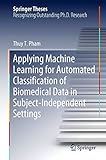Applying Machine Learning for Automated Classification of Biomedical Data in Subject-Independent Settings [electronic resource] / by Thuy T. Pham.
By: Pham, Thuy T [author.] .
.
Contributor(s): SpringerLink (Online service) .
.
Material type:  BookSeries: Springer Theses, Recognizing Outstanding Ph.D. Research: Publisher: Cham : Springer International Publishing : Imprint: Springer, 2019Edition: 1st ed. 2019.Description: XV, 107 p. 35 illus., 32 illus. in color. online resource.Content type: text Media type: computer Carrier type: online resourceISBN: 9783319986753.Subject(s): Biomedical engineering
BookSeries: Springer Theses, Recognizing Outstanding Ph.D. Research: Publisher: Cham : Springer International Publishing : Imprint: Springer, 2019Edition: 1st ed. 2019.Description: XV, 107 p. 35 illus., 32 illus. in color. online resource.Content type: text Media type: computer Carrier type: online resourceISBN: 9783319986753.Subject(s): Biomedical engineeringIntroduction -- Background -- Algorithms -- Point Anomaly Detection: Application to Freezing of Gait Monitoring -- Collective Anomaly Detection: Application to Respiratory Artefact Removals -- Spike Sorting: Application to Motor Unit Action Potential Discrimination -- Conclusion .
This book describes efforts to improve subject-independent automated classification techniques using a better feature extraction method and a more efficient model of classification. It evaluates three popular saliency criteria for feature selection, showing that they share common limitations, including time-consuming and subjective manual de-facto standard practice, and that existing automated efforts have been predominantly used for subject dependent setting. It then proposes a novel approach for anomaly detection, demonstrating its effectiveness and accuracy for automated classification of biomedical data, and arguing its applicability to a wider range of unsupervised machine learning applications in subject-independent settings.


There are no comments for this item.